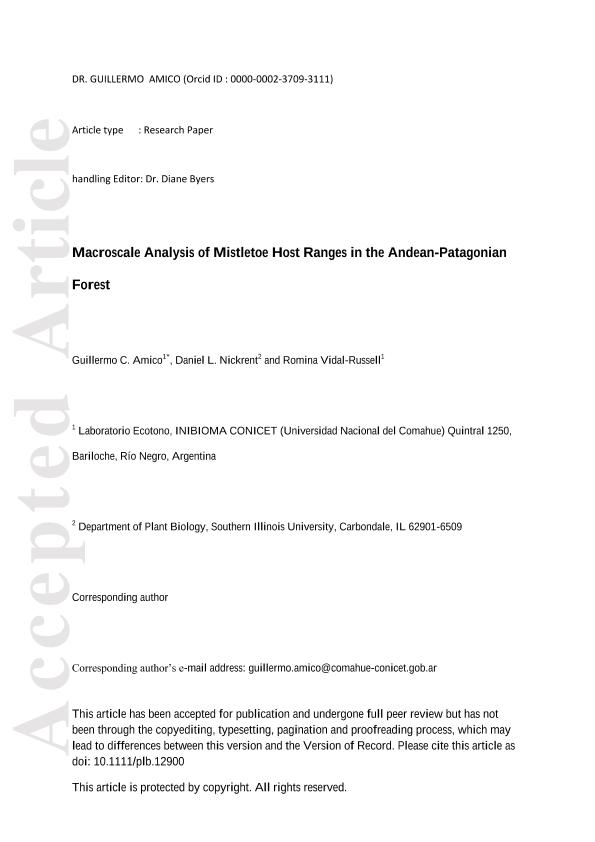Mostrar el registro sencillo del ítem
dc.contributor.author
Amico, Guillermo Cesar

dc.contributor.author
Nickrent, Daniel

dc.contributor.author
Vidal Russell, Romina

dc.date.available
2021-01-08T20:46:26Z
dc.date.issued
2019-01
dc.identifier.citation
Amico, Guillermo Cesar; Nickrent, Daniel; Vidal Russell, Romina; Macroscale analysis of mistletoe host ranges in the Andean-Patagonian forest; Wiley Blackwell Publishing, Inc; Plant Biology; 21; 1; 1-2019; 150-156
dc.identifier.issn
1435-8603
dc.identifier.uri
http://hdl.handle.net/11336/122093
dc.description.abstract
The number of host species infected by a mistletoe (host range) is critical in that it influences prevalence, virulence and overall distribution of the parasite; however, macroecological analyses of this life history feature are lacking for many regions. The Andean-Patagonian forest, found along the southern Andes from 35 °S to Tierra del Fuego at 55 °S, contains 12 mistletoe species in three families (Loranthaceae, Misodendraceae and Santalaceae). By tabulating herbarium records, the host ranges and geographical distributions of these mistletoes were explored. Our results show that these parasites occur on 43 plant species in 24 families but with varying degrees of specificity. All Misodendrum species and Desmaria mutabilis (Loranthaceae) are specialists that use Nothofagus as their primary hosts. Tristerix and Notanthera (Loranthaceae) and Antidaphne and Lepidoceras (Santalaceae) are generalists parasitizing more than six host species from several genera and families. Although many of the mistletoe species are sympatric, there is low overlap in host use. Our data show that in the southern South American bioregion, generalist mistletoes have smaller geographic ranges than specialists. This contrast with a previous hypothesis that predicted mistletoes with large geographic ranges would also have large host ranges, and conversely, less diverse regions would have more specialised mistletoes.
dc.format
application/pdf
dc.language.iso
eng
dc.publisher
Wiley Blackwell Publishing, Inc

dc.rights
info:eu-repo/semantics/openAccess
dc.rights.uri
https://creativecommons.org/licenses/by-nc-nd/2.5/ar/
dc.subject
ANDES
dc.subject
COMPETITIVE EXCLUSION
dc.subject
HOST SPECIFICITY
dc.subject
PARASITIC PLANTS
dc.subject
SOUTH AMERICA
dc.subject.classification
Ciencias de las Plantas, Botánica

dc.subject.classification
Ciencias Biológicas

dc.subject.classification
CIENCIAS NATURALES Y EXACTAS

dc.title
Macroscale analysis of mistletoe host ranges in the Andean-Patagonian forest
dc.type
info:eu-repo/semantics/article
dc.type
info:ar-repo/semantics/artículo
dc.type
info:eu-repo/semantics/publishedVersion
dc.date.updated
2020-11-18T20:50:31Z
dc.identifier.eissn
1438-8677
dc.journal.volume
21
dc.journal.number
1
dc.journal.pagination
150-156
dc.journal.pais
Reino Unido

dc.journal.ciudad
Londres
dc.description.fil
Fil: Amico, Guillermo Cesar. Consejo Nacional de Investigaciones Científicas y Técnicas. Centro Científico Tecnológico Conicet - Patagonia Norte. Instituto de Investigaciones en Biodiversidad y Medioambiente. Universidad Nacional del Comahue. Centro Regional Universidad Bariloche. Instituto de Investigaciones en Biodiversidad y Medioambiente; Argentina
dc.description.fil
Fil: Nickrent, Daniel. Southern Illinois University; Estados Unidos
dc.description.fil
Fil: Vidal Russell, Romina. Consejo Nacional de Investigaciones Científicas y Técnicas. Centro Científico Tecnológico Conicet - Patagonia Norte. Instituto de Investigaciones en Biodiversidad y Medioambiente. Universidad Nacional del Comahue. Centro Regional Universidad Bariloche. Instituto de Investigaciones en Biodiversidad y Medioambiente; Argentina
dc.journal.title
Plant Biology

dc.relation.alternativeid
info:eu-repo/semantics/altIdentifier/url/https://onlinelibrary.wiley.com/doi/abs/10.1111/plb.12900
dc.relation.alternativeid
info:eu-repo/semantics/altIdentifier/doi/http://dx.doi.org/10.1111/plb.12900
Archivos asociados
